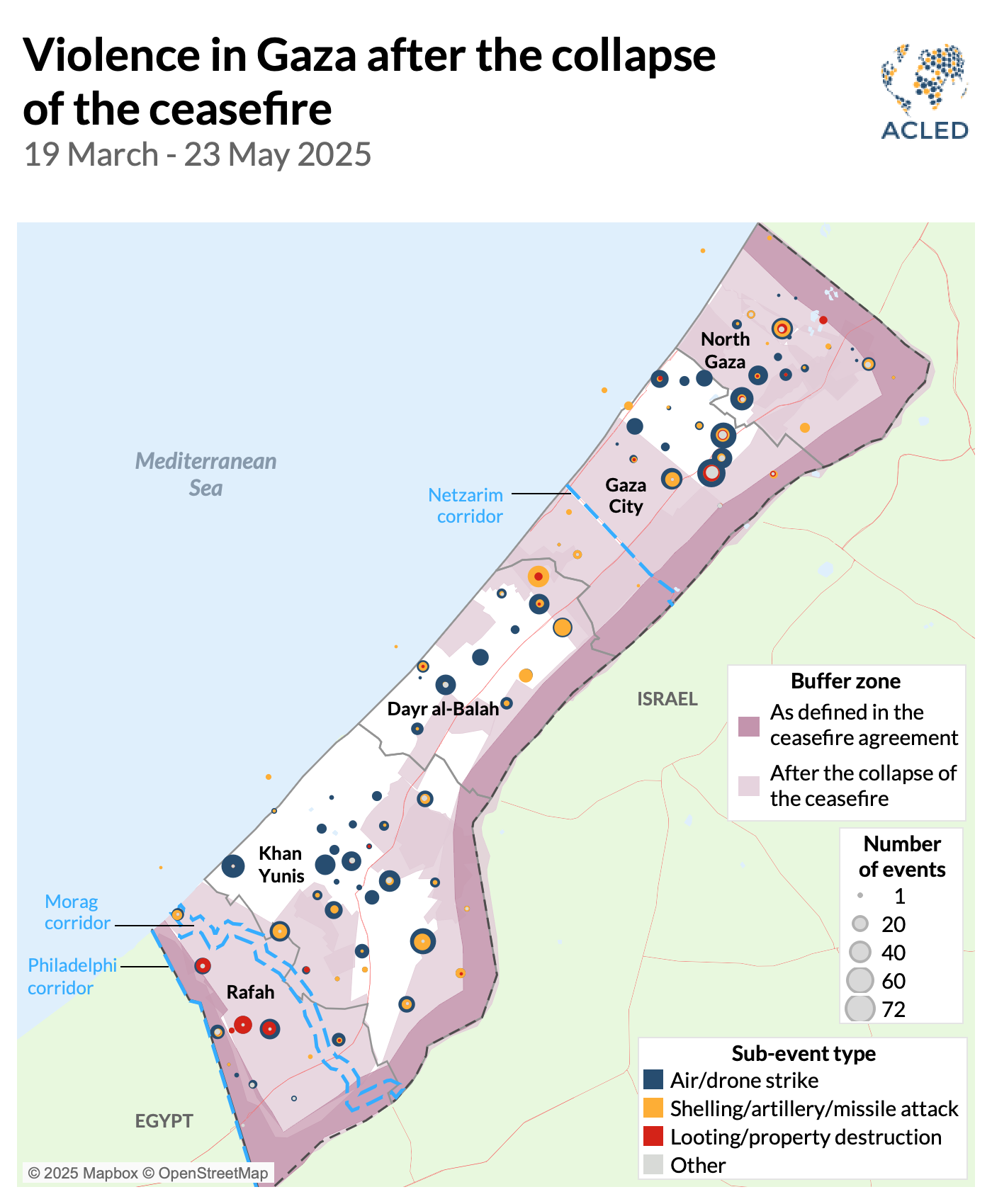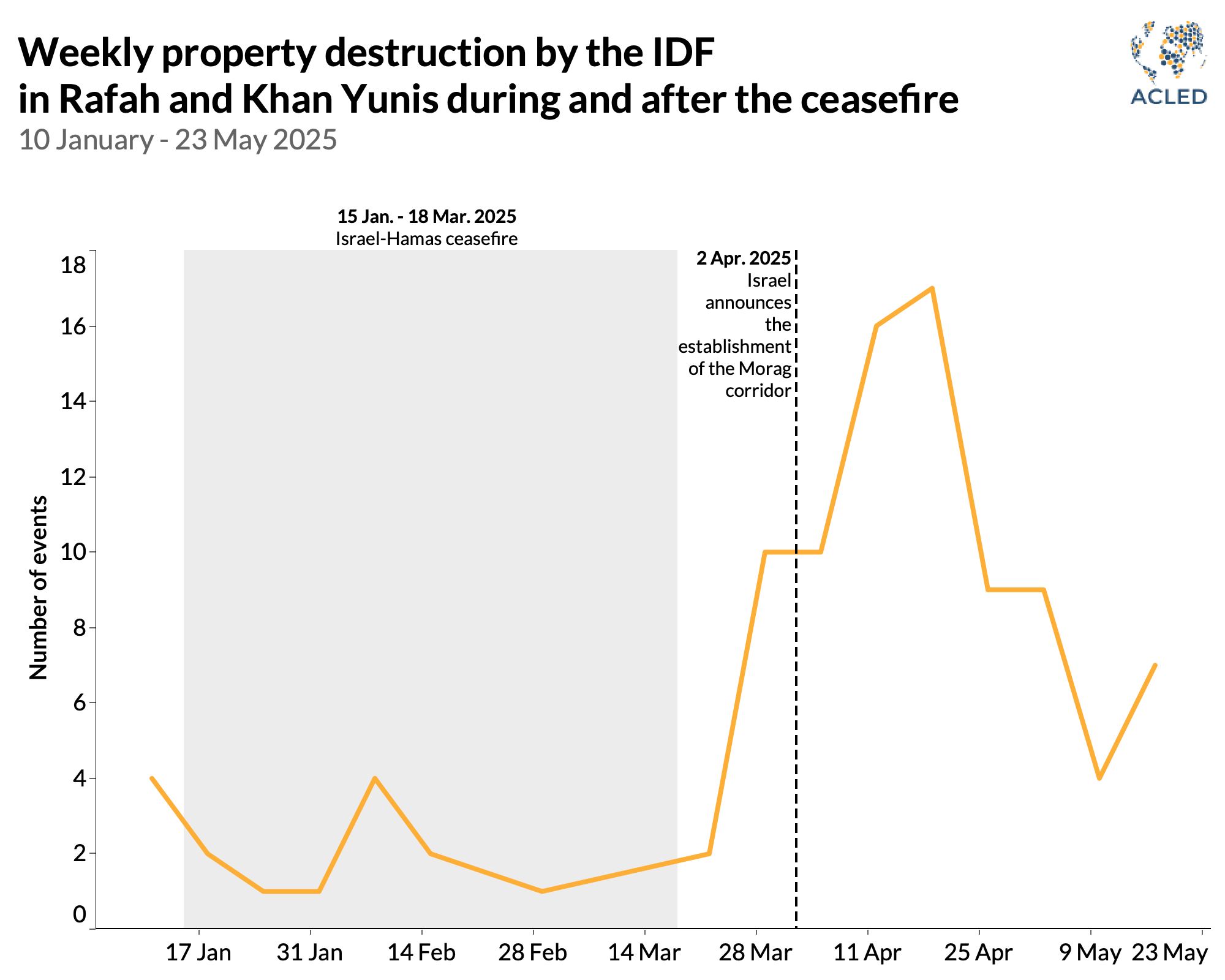
Q&A with
Salma Eissa
ACLED Middle East Research Manager
On 18 May, Israel launched the anticipated ground operation in northern and southern Gaza as international mediators worked to advance ceasefire negotiations. This offensive is part of Israel’s new plan for Gaza, which it has dubbed Operation Gideon’s Chariots. Announced on 5 May, the plan involves “occupying” Gaza and retaining its territories until the achievement of all war objectives.1Jason Burke, “Announcement of Israel’s Gaza occupation plan is carefully timed,” The Guardian, 5 May 2025 This period has been characterized by intensified Israeli airstrikes, escalated ground operations, the expansion of the buffer zone, and a broader territorial sweep into southern Gaza. The renewed offensive came amid an already dire humanitarian situation, with mass displacement into continuously shrinking zones and an aid blockade that lasted over two months.
In this Q&A, ACLED Middle East Research Manager Salma Eissa discusses the nature of violence in Gaza since the collapse of the ceasefire on 18 March, Israel’s evolving strategy, Hamas’ response, and ongoing truce negotiations.

How has the nature of Israeli operations in Gaza changed since the collapse of the ceasefire?
Since the breakdown of the ceasefire on 18 March, Israel has carried out its most intense bombardment of the Gaza Strip since the initial months of the current war in late 2023 (see graph below). This latest aerial campaign has resulted in the deaths of over 3,400 Palestinians, including both civilians and combatants.
Israel has also further expanded the buffer zones and enhanced its ground presence. This new phase, signaled by the launch of Operation Gideon’s Chariots, reflects a shift toward sustained territorial control rather than short-term incursions. This operation has seen Israel call up tens of thousands of reservists2Emanuel Fabian, “IDF calls up tens of thousands of reservists ahead of expanded Gaza offensive,” Times of Israel, 3 May 2025 and move toward what it has called a “sustained presence” in the Strip, with the Israel Defense Forces (IDF) aiming to isolate and fragment areas controlled by Hamas and displace Palestinians to southern Gaza for their potential removal from the territory altogether.3Jason Burke, “Announcement of Israel’s Gaza occupation plan is carefully timed,” The Guardian, 5 May 2025
How has the Gaza buffer zone expanded since the ceasefire ended?
Israel has altered the map of Gaza by expanding the “security zone,” also known as the buffer zone, and issued evacuation orders, which resulted in approximately 70% of the enclave being designated as either a military zone or an evacuation zone, according to the United Nations4David Gritten, “Israeli strikes across Gaza kill 80, hospitals and rescuers say,” BBC News, 14 May 2025 (for more on this, visit ACLED’s Gaza Monitor tool). With the latest announcement of Israel’s plan to control 75% of Gaza within the coming two months, the role of the buffer zone is likely to become increasingly central.5Evelyn Ann-Marie Dom, “Israeli military wants to occupy 75% of Gaza within two months, local media report,” Euronews, 26 May 2025
In addition to the pre-existing Netzarim corridor that cuts through central Gaza and the Philadelphi corridor along the Egypt–Gaza border, Israel created a new security zone known as the Morag corridor, which effectively isolates the southern cities of Rafah and Khan Yunis while aiming to sever connections with the Hamas brigades in those areas.6Jonathan Spyer, “Cutting off Hamas: ‘Post’ visits IDF’s ‘Morag Corridor’ in Gaza,” Jerusalem Post, 21 April 2025 ACLED records 84 property destruction events between the collapse of the ceasefire and 23 May — a five times increase compared to the same period prior (see graph below). In almost all these events, Israeli forces used controlled explosives and bulldozers to raze land in Rafah and Khan Yunis to make way for the new corridor. Although property destruction events have escalated post-ceasefire, the fact that they also took place during the ceasefire suggests that they are likely part of a broader Israeli operational strategy beyond immediate combat needs.
These security zones restrict civilian movement, sever north-south connectivity, and allow Israel to exert more stringent operational control over various sectors of Gaza. At the same time, it has meant that people have been pushed into increasingly overcrowded areas, with the humanitarian zones previously designated as safe no longer recognized as such. Nearly half a million Palestinians in Gaza have been newly displaced post-ceasefire.7Chantal Da Silva and Jiachuan Wu,“No safe place left in Gaza as Israel’s ‘humanitarian zones’ shrink,” NBC News, 4 May 2025
How has Hamas adjusted its tactics since the end of the ceasefire?
On 15 April, Hamas militants targeted three Israeli tanks with anti-tank shells near al-Wafaa Hospital in Gaza City. This was Hamas’ first response to Israeli forces on the ground since the ceasefire broke down. Hamas had remained unresponsive for 28 days, likely in hopes of the reinstatement of the ceasefire. Since then, amid Israel’s continued expansion of its operations, Hamas has resumed engagement, predominantly through guerrilla tactics. However, the current activity level of Hamas is lower than it was before the ceasefire.
This decrease in operations may be indicative of Hamas’ diminished military capabilities. However, it may also be a deliberate strategic decision, potentially influenced by ongoing direct negotiations with the United States, increasing international pressure on Israel, and mounting domestic pressure: On 25 March, Gaza residents launched the first public protests denouncing the group and calling for an end to the war. Hamas — at least for now — has been indicating a preference for preventing further escalation, a stance that might change based on future developments.
In terms of fighting tactics, Hamas is continuing to rely heavily on guerrilla warfare techniques. The use of tunnels, which allow fighters to conduct surprise attacks and move undetected beneath highly surveilled areas, remains a key component. ACLED records at least three tunnel-borne attacks since the breakdown of the ceasefire. Also, the group appears to be exploiting vulnerabilities created by the expanding buffer zone and the establishment of permanent Israeli positions, launching ambushes with IEDs and artillery targeting these positions and adjacent areas. From 15 April to 23 May, ACLED records five lethal Hamas attacks against Israeli forces in North Gaza and Rafah. Seven Israeli soldiers were killed in the attacks.
Where are negotiations, and how are they likely to shape the outcome?
Hamas recently released Edan Alexander, the Israeli-American soldier who was being held hostage in Gaza, as a gesture of goodwill to the Trump administration in hopes of laying the groundwork for a ceasefire.8Yamiche Alcindor and Doha Madani, “Hamas says it will release hostage Edan Alexander in agreement with U.S.,” NBC News, 11 May 2025 The release serves both strategic and symbolic objectives for the group: to convey that it is a relevant negotiating actor in spite of its increasing military setbacks, re-engage in negotiations, and exhibit operational flexibility.
With Israel’s latest expanded ground operation currently underway, Prime Minister Benjamin Netanyahu has assured his coalition party chiefs that the war will not end before Hamas is defeated. This assurance comes even as Israel sends a negotiating team to Doha — at the request of the Trump administration — to restart hostage negotiations with Hamas. It appears that Israel remains committed to continuing negotiations, as Netanyahu promised in March, “under fire.”9Al Jazeera, “Netanyahu: ‘From now on, negotiations will only take place under fire,’” 18 March 2025
These actions do not bode well for a permanent ceasefire, but Israel has made it clear that it would be open to a temporary ceasefire.10Daniel Estrin, “Israel holds ceasefire talks with Hamas, as new ground operation in Gaza begins,” NPR, 18 May 2025 However, Hamas’ continued reluctance to disarm and leave the Strip remains the main sticking point in any agreements. With the US now dropping the demand for Hamas to disarm from the ceasefire deal,11Nurit Yohanan and Emanuel Fabian, “Report: US removes demand to disarm Hamas as part of ceasefire deal,” Times of Israel, 10 May 2025 the group is likely to proceed in talks. However, this point does not seem like something Israel would be willing to relinquish. While a two-month truce is now being discussed, a permanent ceasefire remains highly unlikely at this moment.12Reuters, “Palestinian official says Hamas agrees to Gaza proposal, Israel dismisses it,” 27 May 2025
The improbability of a permanent ceasefire in the immediate future will have substantial repercussions for civilians in Gaza. Millions remain displaced, humanitarian access is shrinking, and large-scale infrastructural damage and essential services deepen with each new phase of the war. Israel’s intent to occupy parts of Gaza, combined with the shift in aid oversight, is likely to deepen an already dire humanitarian crisis.
Visuals were produced by Ciro Murillo.






